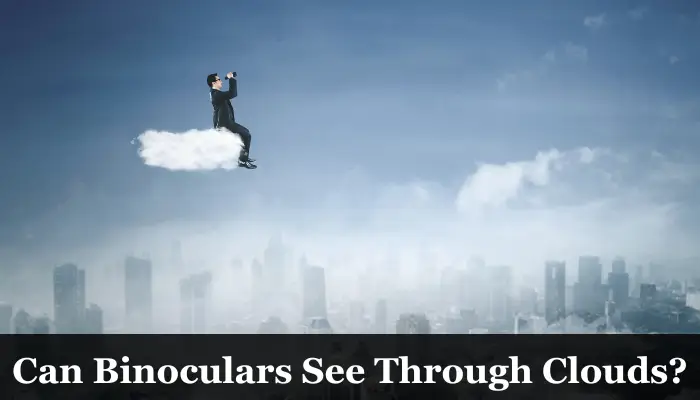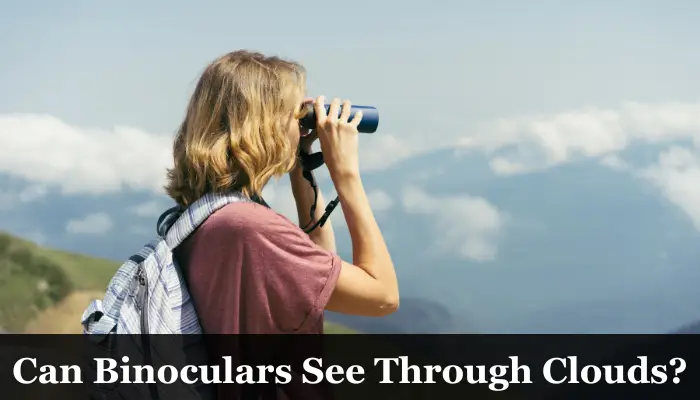This post may contain affiliate links which means I may receive a small commission for purchases made through the links. Learn More
There are many people who love cloud-gazing. They see the flying clouds in the sky. However, the question that is usually asked is if binoculars can see through the clouds or not.
No, binoculars cannot see through the clouds due to the fact that the clouds scatter the light coming towards the binoculars. Due to the scattering of light, the binos offer hazy and unclear visuals. Anything behind the clouds won’t be visible with the binos.
This guide is going to be focused on the visibility through the clouds and whether binos are really effective in giving you a view of anything behind the clouds.
Related: How to Use Binoculars While Wearing Glasses?
Understanding Visibility Through Clouds
Before we go into the details of whether binoculars can see through the clouds or not, we should know the whole visibility mechanism to ensure that there remains no confusion. Actually, it’s all about the light that comes to binoculars.
Clouds are water droplets that actually don’t absorb the light, but they scatter all the incoming light depending upon the wavelength of the light. Suppose there is an objective behind the clouds. The light reflects from the objects and then comes to the binos.
But, there are clouds in between which scatter the incoming light. If the light is scattered, then it won’t focus on the binoculars or on your eyes. So, binos won’t be able to see through what is behind the clouds due to the scattering of the light.
Can you see through the clouds? The same principle applies there as well because the light after reflecting does not reach our eyes. When there is no light, you fail to see the object behind the clouds. If the clouds are thin, then some amount of light will reach your binos, and you’ll end up seeing something.
Can Binoculare See Through Clouds?

No, you cannot see through the clouds by using binoculars. The clouds scatter the incoming light so the objective lens of binos does not capture the incoming light and ends up giving very hazing images. In other words, binos cannot see through the clouds.
You need to understand the functionality of the binoculars. They work when a decent amount of light after the reflecting from the target reaches the binoculars. The objective lens captures that light and focuses it on the prism which reorients the image.
So, when you aim to view the target which is present behind the clouds, the light after reflecting from the target does not reach you due to the clouds in the way. Keep in mind that the clouds do not absorb light, but they scatter and the scattering extent depends on the wavelength of the light.
When the light scatters, then a very small amount of light reaches the objective lens of the binoculars. As a result, you see very unclear visuals. In other words, you fail to see. If the clouds are very thin, and the sun is out, then chances are you’ll be able to see through the clouds. But even at that time, the visuals won’t be super clear.
Can Binoculars See Through Thick Clouds?
Absolutely NOT! It is literally impossible to see through the thick, dense clouds with the help of binoculars. Even the human eye cannot see through such thick clouds even if we are in a higher place and near the clouds.
As I said, the clouds hinder the light. If the light does not reach the objective lens of the binos, you won’t see anything except some hazy visuals. However, if the day is sunny, and there are scattered clouds, then you might end up seeing through them. But visual quality will still be compromised to some extent.
Can Binoculars Be Used To See Through Fog?
Both fog and clouds are quite similar as they consist of tiny water droplets that do not allow the light to pass. So, you cannot see through fog when using the binoculars as the light won’t reach the binos.
As I said earlier the binoculars only work when the light from the targeted body reflects and comes to the objective lens of the binoculars. If a decent amount of light reaches the binos, you will reach that target. Otherwise, you won’t see anything.
As far as the fog is concerned, the light won’t pass through the fog and it will get scattered. Due to the stoppage of incoming light, the objective lens of the binos gets nothing reflected from the target body present behind the fog. So, you won’t see anything through the fog.
Can IR Binoculars See Through Clouds, Fog, And Rain?
No, seeing through clouds, fog, or even through rain is not possible with IR binoculars due to the fact the fog, and clouds do not allow the IR radiations to pass through them which poses a challenge for IR binos as well.
It is important to understand how the IR binoculars work. Every object emits some amount of IR radiation. These radiations are collected or detected by the IR binoculars and you end up seeing the image. There is a complete process and mechanism that converts the radiation or heat into an image.
But if the object is behind the cloud or fog, then the radiation or heat emitted by that object won’t reach the binoculars. The clouds and dense water droplets will absorb or scatter that radiation. This is why IR binoculars cannot see through clouds, fog, and water.
Can A Telescope See Through Clouds?
No, the telescopes also cannot see through the clouds or fog as both binoculars and the telescopes work with the same principle. If the light does not reach their lenses, they won’t give you any visuals.
It is the fact that the telescopes are more powerful than the binoculars, and allow you to see very distant objects shining in the sky. However, when it comes to viewing through the clouds, both telescopes and the binoculars do not help as both fail to get any light.
The clouds scatter the incoming light. As a result, the telescope does not get any light so it could give you magnified visuals. If you are buying a telescope, considering that they are powerful, and allow you to see through clouds, you are wrong! They won’t work when it comes to viewing through the clouds.
Is It Safe to Look at Clouds With Binoculars During the Day?
It is usually safe to view the clouds with the help of binoculars or even with telescopes. You won’t face any issues if you are aiming for cloud-gazing. However, you won’t be able to see through the clouds.
Binoculars are always safe to use no matter for what purpose you are going to use them. Not only for adults, they are safe for kids as well. You don’t need to be worried about the safety when using the binos. However, make sure to take breaks while using it to ensure that your eyes don’t get any strain.
You will only be able to look at the clouds from a distance. You can do that as long as you want. However, due to the scattering of the light, you won’t be able to see through the clouds. Using binos is safe for cloud-gazing no matter how powerful binos you use.
What is the Best Time to Use Binoculars for Cloud-Gazing?
For cloud gazing, the time when the air pressure is on the lower side is the best time to see the clouds flying in the sky. However, there is no restriction about when you should use the binoculars to view the clouds.
Early in the morning, and in the evening, the air pressure usually remains lower. The intensity of the light was also favorable at that time. The turbulence of the particle is also friendly. So, early in the morning, and the evening are the best times for cloud gazing.
In the daytime, it is usually not recommended to do cloud gazing. The reason is that at that time, the intensity of light, and air pressure remains on the higher side. In fact, the turbulence of the particles also remains at higher sides in the daylight.
Conclusion
In conclusion, I would say that using binoculars to view through the clouds is not possible. The reason is that the clouds being water droplets stop the light. Your binos don’t capture the light and you fail to see through the clouds.
However, you can do cloud gazing, and enjoy the beauty of nature. For cloud gazing, early in the morning, and evenings are the best times when you can get a perfect view. I hope that this guide will also be informative and remove your confusion.

I’m a passionate outdoor activist who has got special love for optics. The school studies in optical mechanics and the travelling experience has made me an expert in optics like binoculars, scopes, and other devices. Stay connected with us for in-depth knowledge!

